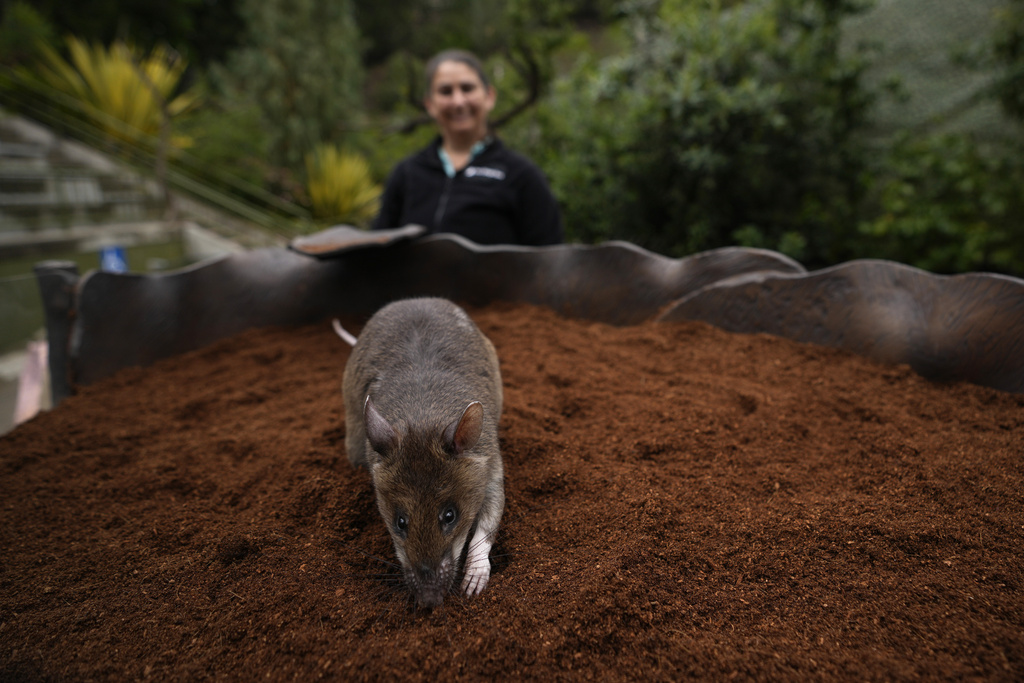As an ambassador for rats, it’s never easy to win over the public. There’s that hairless tail after all.
But Runa at the San Diego Zoo is doing her best to counter the bad press. She is one of a handful of such so-called ambassadors showing off the virtues of rats at three U.S. zoos. The rats were provided by a Tanzania-based organization that is training African giant pouched rats to combat wildlife trafficking, detect diseases and perform other useful tasks.
At least twice the size of the common brown rats found in cities, African giant pouched rats like Runa are best known for ferreting out landmines and other explosive material on old battlefields in Angola, Mozambique and Cambodia, earning them the nickname “hero-rats.” Efforts are underway to expand the use of their keen sense of smell to finding people trapped in collapsed buildings, detecting diseases in laboratory samples and alerting officials to illegal goods at ports and airports.
Six African rats completed their first trial working in the field in March, spending a month at a port in Tanzania where they were tasked with detecting smuggled goods, including Pangolins. The scaly anteater is coveted by poachers and is among the most trafficked animals in the world. Its meat is considered a delicacy in Vietnam and some parts of China, and its scales are used in traditional Chinese medicine.
Wildlife contraband is concealed among vast numbers of shipping containers that annually leave Dar es Salaam in Tanzania and other African ports.
Runa initially was trained to find landmines, but she often got distracted on the job. She has been excelling, however, as an ambassador, said Cari Inserra, lead wildlife care specialist at the San Diego Zoo.

On a recent day, her trainers hid small vessels of chamomile tea under the dirt in a box. As soon as she was released from her cage, Runa’s tiny nose was abuzz with twitching as she set out to work. Within seconds she had found all the vessels, and was racing over to suck on a syringe filled with a pellet-and-banana smoothie.
“One of the most fun things to see is how she changes the perceptions of people,” Inserra said.
Nicki Boyd, of the San Diego Zoo and Wildlife Alliance, said rats offer an important tool to combat wildlife trafficking, which the zoo wants to highlight since the illegal animal trade “is very destructive to the species that we are actively trying to save and protect in the wild.”
“I do think there is the ability to scale this up,” she said.
But rats still have a ways to go in winning over everyone. Last week, New York Mayor Eric Adams introduced Kathleen Corradi, a former elementary school teacher and anti-rat activist, as his new “rat czar” whose job is to battle potentially millions of rats lurking about the city.
The city’s help-wanted ad for the post stated it was seeking applicants who are “bloodthirsty,” possess “killer instincts” and could commit to the “wholesale slaughter” of rats. At her first news conference in her job, Corradi, standing next to Adams, stated her hatred of rats and vowed to use “science” to rid the city of them.
Rats can spread disease like leptospirosis, which on rare occasions can lead to meningitis and cause the kidneys and liver to fail.
Izzy Szott, a behavioral research scientist at the Tanzania-based organization APOPO, which is training the rats to work for governments, said she was not surprised to hear rats had been named enemy No. 1, but she wants people to know the full picture. Her hope is having ambassador rats at renowned zoos, like San Diego’s, will lead to more understanding and support for rat research.
New York City spokesman Fabien Levy called his city’s rats “dirty, diseased” and a public health risk that the city is intent on ridding itself of using humane techniques where possible. But he added: “Our priority remains our city’s residents, not its rodents.”
Rats in general, Szott said, “actually are quite clean animals,” adding that they groom themselves constantly and often affectionately lick their trainers’ arms after getting a good scratching.
Szott said rats often “get a bad rap,” but that it’s important to “consider our responsibility towards the wildlife around us and that we share the planet with.”
“We need to understand the capabilities that these animals have and see them in a humane way and treat them in a humane way,” she added.
African giant pouched rats have sniffed out more than 150,000 landmines to date, according to her organization. They’ve also helped health clinics in Africa diagnose people with tuberculosis, detecting the bacteria in the sputum samples of 25,000 patients.
At their facility in Morogoro, Tanzania, Szott and the other researchers are also working on training the rats to someday aid in the detection of contaminated soil or help rescuers in finding people trapped under the rubble after earthquakes and explosions. The rats, which can be dispatched into hard-to-reach areas, have been outfitted with tiny vests with a pendant they can pull to send an alert to their handlers when they find a person. So far they have succeeded in alerting their handler when given such a task in a mock disaster setting, Szott said.
And Szott said she believes someday they could be a regular fixture at some ports and airports, offering a cheaper option to drug-and-explosive-sniffing dogs. One of her program’s rats has already shown they can sniff out multiple species, she said, adding that they could be used to stop the trafficking of elephant ivory and rhino horn.
New York City’s common brown rats share the same traits, but their shorter lifespan makes them unlikely candidates for such trainings, Szott said. African rats can live up to a decade whereas small brown rats only live for a few years.
“We think they make great zoo additions,” she said of the African rats, adding that the ambassadors will broaden people’s understanding of “just how smart they are and how we can co-exist with them.”
(AP)











